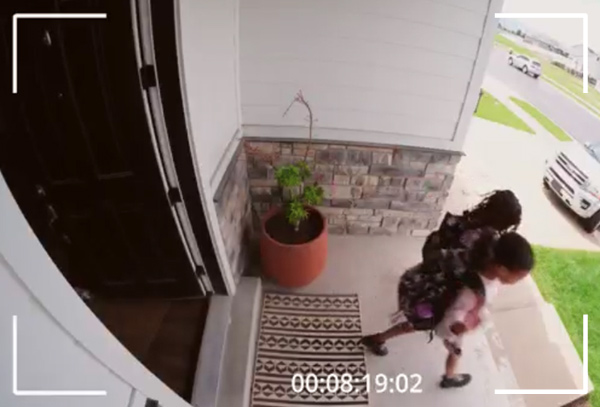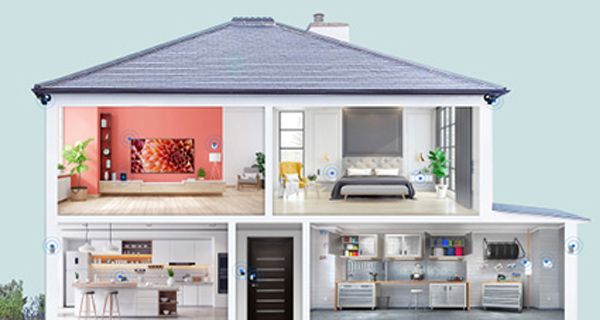A Guide to Video Doorbells
Select the right one for your customer
Select the right one for your customer
Video doorbells, also known as doorbell cameras, have revolutionized home security by providing real-time visual and audio communication between visitors and homeowners. Unlike traditional doorbells and chimes, which only alert homeowners to someone's presence, the best video doorbells offer the added benefit of seeing and speaking to visitors remotely. This enhanced video doorbell functionality not only deters potential intruders but also allows homeowners to monitor package deliveries and interact with guests from anywhere, significantly boosting the overall security and convenience of modern homes.
With many options available today, it's important to understand the specifications, compatibility issues and customer needs before selecting a video doorbell. When you're ready to choose one for your customer, use this video doorbell buying guide to navigate the key considerations and features.
Ensuring the safety of your customer's home today is paramount. Video doorbells have emerged as a must-have in modern home security systems, offering a range of benefits that provide security, convenience and peace of mind. As part of a broader suite of intrusion systems and wireless intrusion products, video doorbells are reshaping how you can help homeowners monitor and protect their properties.
Video doorbells also serve as an additional layer of security for the home. Equipped with motion detection, two-way audio, and live streaming capabilities, video doorbells act as powerful deterrent against potential intruders or thieves.



Advanced motion sensors detect activity near your customer's doorstep and send instant alerts to their smartphone. This feature ensures your customers are aware of any unusual activity, whether they're home or away.
With built-in microphones and speakers, video doorbells allow communication with visitors or delivery personnel. This functionality can discourage suspicious individuals by creating the impression that someone is home.
Real-time video feeds enable customers to view their doorstep at any time, offering 24/7 monitoring. Combined with high-definition video recording, this feature provides valuable evidence in the event of a security incident.
The surge in online shopping has undoubtedly led to an increased risk of package theft. Video doorbells help mitigate this concern by allowing homeowners to monitor deliveries remotely. They can verify when packages arrive and ensure they are safely retrieved. Similarly, video doorbells help your customer keep an eye on visitors, whether it's friends, family or unexpected guests.
One of the standout advantages of video doorbells is the ability for homeowners to access live video feeds, review recorded footage and receive notifications, all from a smartphone app. Remote access ensures your customers stay connected to their home, regardless of their location. This feature is especially beneficial for frequent travelers and busy professionals.
Today, video doorbells are either hardwired or wireless, but they do come with a variety of features that impact the level of security and functionality. While there are basic video doorbells all the way to high-end models, it's important to understand the key features available in most types of video doorbells before recommending one to your customer.
Wired and wireless video doorbells differ primarily in their power source and installation requirements. Wired video doorbells connect directly to a home's electrical wiring, providing a constant power supply and often a more stable connection. They are ideal for homeowners with existing doorbell wiring and are generally less dependent on battery maintenance.
In contrast, wireless video doorbells rely on rechargeable batteries for power, offering greater flexibility during installation since they do not require electrical wiring. This makes them an excellent choice for renters or properties without pre-existing doorbell systems. While both types of doorbell cameras offer features like HD video, motion detection and app-based controls, the choice between wired and wireless depends on the user's preference for ease of installation versus long-term maintenance and reliability.
The key difference between basic and smart video doorbells lies in their features and capabilities. Basic video doorbells typically offer essential functions such as video recording, motion detection and two-way audio, allowing users to see and communicate with visitors. These models are straightforward and affordable, making them ideal for users who need standard security features without extra complexities.
Smart video doorbells, on the other hand, include advanced functionalities like AI-powered facial recognition, customizable motion zones and integration with smart home ecosystems and smart home products. They often allow remote access via mobile apps, enabling users to monitor and control their doorbell from anywhere. In general, smart models are perfect for tech-savvy users or those seeking enhanced security and convenience through automation and connectivity.
Finding the right video doorbell for your customer starts with assessing their needs. Also consider whether your customers want a wired or hardwired video doorbell based on installation options and power requirements. Keep reading to learn about the various features typically found in a video doorbell in order to choose the right one for your customer.

Video quality is crucial when selecting a video doorbell because clear visuals help identify visitors and intruders more effectively. High-definition (HD) video, typically 1080p, provides sharp and detailed images, sufficient for recognizing faces, reading license plates or spotting activity near the door. However, 4K resolution offers even greater clarity with four times the detail of HD, allowing for superior zooming without sacrificing image quality. This is particularly beneficial for homes or businesses in areas with high traffic or where enhanced detail is necessary for security purposes. Choosing the right resolution depends on your customer's specific needs and whether the network can support the higher bandwidth requirements of 4K video.

When comparing battery-powered and hardwired video doorbells, each has its own set of advantages and drawbacks. Battery-powered doorbells, including many wireless doorbell camera models, offer flexible installation without the need for electrical wiring, making them ideal for renters or homes without existing doorbell setups. They can be placed anywhere within Wi-Fi range and are easy to move if needed. However, they do require regular battery charging or replacements, which can be a maintenance consideration. On the other hand, hardwired doorbells are connected directly to the home's electrical system, providing a constant power supply and more reliable performance. They are less likely to run out of power and often offer stronger connectivity, but installation can be more complicated. The choice between the two comes down to your customer's preference for convenience versus long-term reliability and power consistency.

Motion detection and alerts are essential features of modern video doorbells, enhancing home security by notifying users of any unusual activity near their door. The ability to detect motion helps ensure that customers are aware of visitors or potential intruders before they reach their doorstep. Customizable motion zones allow users to define specific areas to monitor, reducing false alarms that are caused by passing traffic or pets. This customization ensures that alerts only trigger when there is meaningful activity, making the security system more efficient. Real-time alerts, delivered via mobile apps or connected smart devices, ensure that customers can respond quickly to potential threats or unexpected visitors.

Two-way audio in a video doorbell allows users to not only see but also communicate with visitors in real time through their smartphone or connected device. Whether it's a delivery person, a guest or a potential intruder, two-way audio enables users to issue instructions, ask questions or deter unwanted behavior, all without having to physically open the door. This added layer of security helps improve safety by allowing homeowners to assess the situation and respond appropriately from a distance. Additionally, two-way audio can be especially useful for answering questions about packages, scheduling deliveries or speaking with guests when your customers are not home, making it a versatile tool for modern home security and convenience.

Smart home compatibility and app integration are vital considerations when choosing a video doorbell, as they enhance the convenience and functionality of the device. A video doorbell that integrates seamlessly with popular smart home platforms like Amazon Alexa or Google Assistant allows users to control and monitor their doorbell using voice commands and other smart devices. This compatibility can enable automated routines, such as turning on porch lights when the doorbell rings or streaming the video feed to a smart display. App integration further extends convenience, providing a centralized interface for users to view live footage, review past recordings, customize settings and receive real-time alerts from a smartphone or tablet.

When choosing a video doorbell, customers often face the decision between models that require a subscription and those that don't. Subscription-based doorbell cameras typically offer cloud storage for recorded footage, advanced features like smart notifications and access to video history, ensuring that users can review past events and maintain a comprehensive security record. However, this comes at an additional monthly or yearly cost. On the other hand, a doorbell camera without a subscription may not include cloud storage but can still provide essential features like live streaming, real-time alerts and basic motion detection without any ongoing fees. Some customers prefer subscription-free models to avoid extra expenses and because they may only need the live-view function or choose to store video locally on a smart device or an external storage solution. This option appeals to budget-conscious users or those who prioritize simplicity and cost-effectiveness in their home security setup.

Night vision and weather-resistant features are crucial for ensuring 24/7 security and reliable outdoor performance of video doorbells. Night vision allows the doorbell camera to capture clear, detailed footage even in low-light or dark conditions, enabling homeowners to monitor activity around their door during any time of the day. This is particularly important for identifying visitors or potential intruders during nighttime hours, ensuring that security remains effective around the clock.
Weather-resistant features protect the video doorbell from environmental elements like rain, snow, heat and extreme temperatures, ensuring it operates smoothly in various weather conditions. With durable, weather-proof construction, video doorbells can maintain high performance and reliability throughout the year, making them an essential part of a home's security system regardless of the weather.
With a clear understanding of the key differences between video doorbells and your customer's unique needs, you're now equipped to recommend the ideal solution. Use this video doorbell guide to confidently match customers with the perfect video doorbell that enhances their security and convenience.

Use our interactive page to explore products in the entry, kitchen, living room and backyard and shop by brand or category.

Learn what you need to know about routers and mesh Wi-Fi systems.
